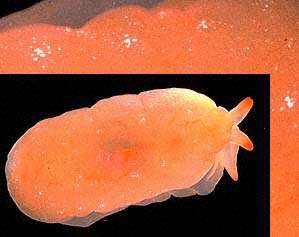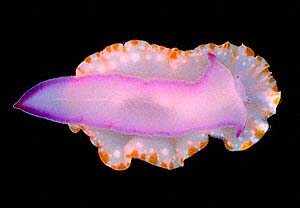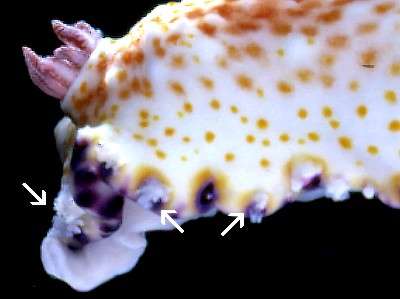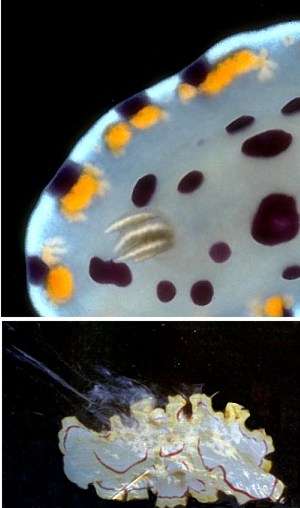

Defensive glands
PHOTO
TOP: Berthellina citrina, showing the white mantle glands in its skin. (magnified glands in background).
LOWER: Mexichromis macropus, view of the underside showing the round opaque white mantle glands around the mantle edge.
Photos: Bill Rudman.
RELATED TOPIC
Mimicry - Phyllidiella, flatworms, Chromodoris
As I have discussed elsewhere on the Forum, one of the main means of defence in sea slugs is to have distasteful, sometimes toxic, chemicals stored in the body. In many cases small microscopic glands occur all over the skin and exude secretions, when the animal is disturbed. There are more elaborate developmenst in some groups of animals in which the secretions are stored in larger specialised glands or sacs.
See:
• Chemical ecology
• Chemical ecology of the nudibranch Glossodoris pallida.
• References: Chemical defence in Phyllidiidae.
• References: Acid Glands and Acid secretions.
• Skin secretion in Pl. forskalii
• Acid secretion in Pl. forskalii
• Use of algal compounds for defence in Elysiella pusilla
• Streaming milky secretions in Glossodoris cincta.
Rudman, W.B., 2004 (July 27) Defensive glands. [In] Sea Slug Forum. Australian Museum, Sydney. Available from http://www.seaslugforum.net/find/mucus
Related messages
Re: Predation by Humans?
September 28, 2001
From: Peter H. van Bragt
Hello Bill,
Regarding the anecdote on human predation, I made some inquiries at the Center For Steinbeck Studies at San José State University, San José, California, U.S.A.. Susan Shilling and Katie Rodger, were very helpful and after some research they send me the following message:
========
Dear Dr. van Bragt,
Thank you for your interesting request. The only reference similar to your inquiry that I could find was in Steinbeck's essay "About Ed Ricketts" published with the Log from the Sea of Cortez. In the essay,
Steinbeck writes:
"Once in a tide pool we were discussing the interesting fact that nudibranchs, although beautiful and brightly colored and tasty-looking and soft and unweaponed, are never eaten by other animals which should have found them irresistible. He reached under water and picked up a lovely orange-colored nudibranch and put it in his mouth. And instantly he made a horrible face and spat and retched, but had found out why fishes let these living titbits completely alone. On another occasion he tasted a species of free-swimming anemone and got his tongue so badly stung by its nettle cells that he could hardly close his mouth for twenty-four hours. But he would have done the same thing the next day if he had wanted to know."
This comes from page 264 in the 1995 Penguin edition of The Log from the Sea of Cortez. Katie Rodger, Curator, Center For Steinbeck Studies.
==============
I guess that this describes sufficiently the outcome of the experiment. As far as I'm concerned, there is no need for further experiments.
Greetings from the Netherlands
Peter H. van Bragt
vanbragt.phjm@hsbrabant.nl
van Bragt, P.H., 2001 (Sep 28) Re: Predation by Humans?. [Message in] Sea Slug Forum. Australian Museum, Sydney. Available from http://www.seaslugforum.net/find/5340Thanks Peter,
Bill Rudman
Re: Predation by Humans?
September 17, 2001
From: Scott Johnson

Hi Bill,
Peter's story about John Steinbeck's nudibranch encounter may refer to an anecdote Steinbeck related in his book Log of the Sea of Cortez. Steinbeck was a good friend of Ed Ricketts, a biologist who was the inspiration for Cannery Row. Speaking of Ricketts, Steinbeck wrote:
"He reached under the water and picked up a lovely orange-colored nudibranch and put it in his mouth. And instantly he made a horrible face and spat and retched, but he had found out why fishes let these living tidbits completely alone."
Afraid I don't have publication details of the book since I cannot find my old battered copy. But if you can find it, I recommend it. It is an often amusing tale of a collecting expedition the two men made to Mexico's Sea of Cortez in the late 1930's or 40's. How times have changed -- in some ways, at least.
Scott
johnson@kmr.ll.mit.edu
Johnson, S., 2001 (Sep 17) Re: Predation by Humans?. [Message in] Sea Slug Forum. Australian Museum, Sydney. Available from http://www.seaslugforum.net/find/5279Thanks Scott,
I wondered about the Sea of Cortez book - but like you I could't find a copy I used to have. I agree its a wonderful read for anyone with even a passing interest in the marine biology. There is a recent Penguin paperback reprint if anyone's interested.
Cheers,
Bill
Predation by Humans?
September 16, 2001
From: Peter H. van Bragt
Dear Bill,
Browsing through your site, I found the page about predation on seaslugs. I wonder if you have ever heard of the following anecdote.
John Steinbeck, the world famous best-seller author (e.g. Cannery Row and Grapes of Wrath), with a vivid interest in marine biology, supposedly has investigated the content of cnidosacs, by volunteering as a guinea pig himself. It is said that he bit into a large seaslug to test its level of toxicity. As I understand it, he did not really eat the whole animal, but did suffer a great nuisance as his lips were covered with blisters for several weeks.
I am sorry to say that I do not have a proper reference for this anecdote. Maybe somebody else can confirm this story. Unfortunately we cannot ask the man himself about these experiences as he died 20 Dec. 1968.
Best regards
Peter H. van Bragt
vanbragt.phjm@hsbrabant.nl
van Bragt, P.H., 2001 (Sep 16) Predation by Humans?. [Message in] Sea Slug Forum. Australian Museum, Sydney. Available from http://www.seaslugforum.net/find/5235Thanks Peter,
No I hadn't heard this story but perhaps one of our Californian friends can enlighten us.
Best wishes,
Bill Rudman
Natural products from Sea Slugs
March 2, 2001
From: Arnaud Parenty
Hi Bill,
During my Ph D, I have to give a lecture about a chemical subject. I would like to speak about natural products extracted from sea slug and their applications as cytotoxic agents, antifungal agents etc ...
Is there any review or full paper about that ? Could you give me information about this subject ?
Thank you very much
Best regards :)
Arnaud
arnaud.parenty@icsn.cnrs-gif.fr
Parenty, A., 2001 (Mar 2) Natural products from Sea Slugs. [Message in] Sea Slug Forum. Australian Museum, Sydney. Available from http://www.seaslugforum.net/find/3874Dear Arnaud,
There is quite a lot of information stored in the Forum. One simple way to find it is to use the SEARCH button in the blue bar at the top and bottom of each page, and also in the yellow band above each message. If you type in something like natural products you will get a list of potentially interesting pages or messages to look at. Or just go to the GENERAL TOPICS list and look for relevant pages.
For example have a look at the Defensive Glands Page and the Opisthobranch defence mechanisms page. Another relevant one is the Sea Hares - attack & defence page which contains a list of scientific references. In particular, have a look at Conxita Avila's invaluable 1995 review.
In a little exercise in quality control I just tested the SEARCH facility on the Forum by typing in antifung* to get antifungus, antifungal etc and was given the Hexabranchus references page which has a relevant antifungal reference and an antitumor reference. I also typed in antitumor and was directed to Kirsten Benkendorff's very relevant message.
So happy hunting,
Best wishes,
Bill Rudman
Sea Slugs producing sulfuric acid
May 2, 2000
From: Foisy
Does anyone know why/how sea slugs produce sulfuric acid?
Thanks!
Foisy
Phlarn83@AOL.com
Foisy, 2000 (May 2) Sea Slugs producing sulfuric acid. [Message in] Sea Slug Forum. Australian Museum, Sydney. Available from http://www.seaslugforum.net/find/2342Dear Foisy,
The most commonly cited example of sea slugs producing sulphuric acid are the notaspidean pleurobranchs. Go to the SPECIES LIST [see navigation bar at top and bottom of each page] and have a look at the species listed under ORDER NOTASPIDEA, Superfamily Pleurobranchomorpha for some examples. Have a look at the photo of Berthellina citrina at the top of this page for a good example of these glands.
It has been suggested that these animals store acids from their food, but most of the evidence suggests that they produce the acid secretions themselves from large epithelial and subepithelial glands in their skin. These glands can be found in all parts of the skin, other than the gills.
There are many observations that these acid secretions are distasteful to prey and it is presumed that the sea slugs produce them as a defence against being eaten.
Have a look at the list, I have prepared, of research publications on acid secretions and have a look at the page on
Defensive Glands.
Bill Rudman.
Rudman, W.B., 2000 (May 2). Comment on Sea Slugs producing sulfuric acid by Foisy. [Message in] Sea Slug Forum. Australian Museum, Sydney. Available from http://www.seaslugforum.net/find/2342Chemical Defences in nudibranchs
April 30, 2000
From: Victor Bonito
Dear Bill,
I am interested in learning more about the aposematic colouration of flatworms and nudibranchs. While a lot of books refer to nudibranchs as being aposematic and sequestering chemicals from their food sources, I can not find any literature to support this. In the cases of flat worms mimicking nudibranchs, is there literature to support the fact that the nudibranchs
are in fact chemically defended (other than L. Newman's work with flatworms)? I am especially interested in Phyllidids, and any feeding assays that have been done with chemicals extracted from them.
Thank for your direction in finding some publications in this area.
Sincerely,
Victor Bonito
University of Guam
staghorncoral@hotmail.com
Bonito, V., 2000 (Apr 30) Chemical Defences in nudibranchs. [Message in] Sea Slug Forum. Australian Museum, Sydney. Available from http://www.seaslugforum.net/find/2336Dear Victor,
There is certainly a lot of published evidence to show that some groups of nudibranchs retain chemicals, from their food, for their own defence.
I have compiled a page of •references to chemicals in Phyllidiidae for you. It also includes two references to two major reviews which have excellent bibliographies.
If you use the SEARCH button you will find a lot of references to defence and mimicry in the Forum. In particular have a look at the pages on:
•Opisthobranch defence mechanisms
•Mimicry
•Defensive mantle glands.
There are references associated with those pages as well. Also look at the messages on each page because they also contain comments and references which may be worth following up.
Best wishes,
Bill Rudman.
Chemical defence & reproductive strategies
November 15, 1999
From: Sarah Priestley
Hi,
I'm a final year student and I'm doing my dissertation on dorid nudibranchs. Your pages are really useful but I wondered if you knew of any recent work that has been done and written in journals, especially about chemical defense and reproductive strategies.
Thanks for your help
Sarah
bgy7sep@leeds.ac.uk
Priestley, S., 1999 (Nov 15) Chemical defence & reproductive strategies. [Message in] Sea Slug Forum. Australian Museum, Sydney. Available from http://www.seaslugforum.net/find/1525Dear Sarah,
There is a lot on the Forum on chemical defence. Have a look at the pages on Defensive glands and Nudibranch Defence for links to other sites. Be sure to look at the messages on each page as there is a lot of supplementary to be found there. Also use the Search the Forum button.
I've listed a couple of recent reviews below on chemical defence which would be worth reading. I'm afraid I don't know of any recent review on reproductive strategies but there is a good review on reproduction in Thompson & Brown (1984) of work in the preceding decade (pp 164-7).
Best wishes,
Bill Rudman.
•Avila,C (1992): A preliminary catalogue of natural substances of opisthobranch molluscs from western Mediterranean and near Atlantic. Scientia Marina 56(4): 373-382.
•Avila, C. (1995): Natural products of opisthobranch molluscs: a biological review.
Oceanography and Marine Biology: an Annual Review 33: 487-559.
•Thompson, T.E. & Brown, G.H. (1984) Biology of Opisthobranch Molluscs, Vol 2. Ray Society: London.
Do chromodorid mantle glands have a pore?
November 9, 1999
From: Bill Rudman

While preparing a page on Chromodoris aureopurpurea I came across this photo I took of an animal showing the extrusion of the intact mantle glands from a 'pore' in the dorsal surface of the mantle. In every case the 'pore' was in the centre of the dark purple spots around the mantle edge.
There is considerable debate about how the distasteful metabolites within the mantle glands (Mantle Dermal Formations) are 'released' or come into contact with potential predators. On one hand, as Garcia et al (1991) have shown, it is not possible to find a pore in the mantle epithelium for secretion to take place. However as you can see in my photo of Glossodoris rubroannulata accompanying my answer to an earlier question, some species do produce a milky substance which appears to be secreted.
This photo of C. aureopurpurea suggests that more than one means of delivering the metabolites may be used by different species. In this case it appears that the whole branching gland has 'popped out'. As all the glands have emerged in the same place, from a purple spot, it would suggest that this is not just a random breaking of the skin, but through a structural 'weak spot' or pore.
What caused the animal to do this? It happened the night the animal had been caught and was apparently stressed. I have often seen specimens of Hypselodoris 'pop' out their single unbranched glands around the posterior end of the mantle, usually when they are being narcotised.
I add this observation to the general debate.
Bill Rudman.
[Specimen from: Green Point, Sydney Harbour, New South Wales, Australia. 7m, June 1982, 34mm long alive].
References:
•Avila, C. & Durfort, M. (1996). Histology of Epithelia and Mantle Glands of selected species of Doridacean mollusks with chemical defensive strategies. The Veliger, 39(2): 148-163.
•Garcia, J.C., Medina, A. & Coveras, R. (1991). Study of the anatomy and histology of the mantle dermal formations (MDFs) of Chromodoris and Hypselodoris (Opisthobranchia: Chromodorididae). Malacologia, 32(2): 233-240.
Re: Defensive allomones in nudibranchs
June 7, 1999
From: Wayne Ellis
Hi Dan,
Have you seen Tim Judd's review on the web.
Regards
Wayne
glaskin@ozemail.com.au
Ellis, W., 1999 (Jun 7) Re: Defensive allomones in nudibranchs. [Message in] Sea Slug Forum. Australian Museum, Sydney. Available from http://www.seaslugforum.net/find/925Thanks Wayne,
I thought I had a reference to Judd's review somewhere on the site, but I can't find it. Its an excellent summary.
Bill Rudman.
PS: Found it! In an answer to Austin on feeding in Hypselodoris zebra, last November.
Aposematism - experimental evidence?
June 7, 1999
From: Russell Wyeth
Hello everyone,
We are working on experimentally proving that bright slugs are so coloured as warning to predators that they taste bad (aposematic). Are there thoughts on some visual predators which will sample and then spit out nudibranchs? We have thought of large shrimp, some crab species, and fish such as kelp greenling and maybe some sculpins... Our work is on northeast pacific animals, but I'd welcome thoughts from anywhere.
Cheers,
Russell Wyeth
University of Washington
Department of Zoology
Box 351800
Seattle, WA 98195-1800
rwyeth@u.washington.edu
Wyeth, R., 1999 (Jun 7) Aposematism - experimental evidence?. [Message in] Sea Slug Forum. Australian Museum, Sydney. Available from http://www.seaslugforum.net/find/926Dear Russell,
There is quite a bit about aposematism on the site. Have a look at this page, above and below your message) and have a look at the Defence topics in the General Topics list. Unfortunately there is not much direct experimental work that has been done which goes beyond the pioneering work of Crossland who 90 years ago was throwing bits of chromodorids to fish off his houseboat in the Sudanese Red Sea!
I'm off to Italy today so won't be able to get back to your message for a couple of weeks. Also perhaps you would like to add some information about your research etc for the Participants Page.
Best wishes,
Bill Rudman.
Defensive allomones in nudibranchs
June 6, 1999
From: Dan Sanchez
I am attempting to find information regarding the ability of nudibranchs to sequester secondary compounds from other organisms for use as allomones. What types of organisms do they get these from, how do they use them, why are their bodies able to recognize them as not being foreign, and which nudibranchs can do this?
Dan Sanchez
otisimo@hotmail.com
Dear Dan,
Perhaps first I should define allomone for anyone not sure of its meaning. Its basically refers to a chemical secreted or released by an organism which cause a specific response when detected by an organism of a different species.
Have a look at Opisthobranch Defence Mechanisms which gives you a list of pages with relevant information. In particular, the Sea Hares - Chemical Defence is a bibliography of relevant papers, not only on Sea Hares but other opisthobranchs as well. One paper you should be able to obtain is Avila, 1995 which is an excellent review article. When you look at any of the pages don't forget to look at the messages and answers at the bottom of each page. They usually contain a lot more information.
Probably the most spectacular example of allomone use is found in the Chromodorididae, where all species concentrate chemicals obtained from the sponges they feed on in special glands around the mantle edge. In southeastern Australia many species have evolved a red-spotted colour pattern in a great geographic display of defensive mimicry. I have recently posted a group of pages illustrated some of these red-spotted species (message 1, message 2).
Other groups of similarly coloured species are found elsewhere, the Mediterranean being well-known for a series of blue species with yellow markings.
Another sponge-feeding dorid family with particularly nasty chemical defence are the Phyllidiidae. Have a look at the Mimicry page for a good example.
Other nudibranchs which don't feed on sponges also use chemical defence. Two quite unrelated feeders on soft-corals also harbour chemicals retained from their soft-coral food. Have a look at the information on the aeolid genus Phyllodesmium (Aeolid Ceras, Phyllodesmium longicirrum and Autotomy). I haven't got much specifically on the arminids, which also sequester chemicals from soft-corals, but have a look at the Dendronephthya-feeding page for an example.
I hope this will give you some help,
and don't forget to look at the messages below yours on this page.
Best wishes,
Bill Rudman.
Defensive Glands in Hypselodoris
May 21, 1999
From: Austin
Dear Bill,
And now for my continuing passion over Hypselodoris slugs.
Concerning Hypselodoris webbi and H. villafranca, the Avila et. al. (1991) paper suggests that the yellow-colored mantle dermal formations (MDF) where defensive allomones are concentrated, are located along the yellow border of the mantle so as to be camouflaged from would-be predators. Is there such a common trend from your observations that MDFs generally are the same color as body color markings? Or could this simply be a case of "fortuitous" overlap with the body color region? It seems more plausible that MDF location is more under selection for location (i.e. near important body parts like the gills and rhinophores) rather than color.
How do sea slugs produce mucus and where is it secreted? [ I'm thinking of the observation that the two Hypselodoris nudibranchs secrete a white mucus full of ichthyodeterrent furanosesquiterpenoids Avila et al., 1991).]
Thanks, Austin
jaustin@bio.fsu.edu
Austin, J, 1999 (May 21) Defensive Glands in Hypselodoris. [Message in] Sea Slug Forum. Australian Museum, Sydney. Available from http://www.seaslugforum.net/find/723
Dear Austin,
Sorry its taken me a while to answer this question. I guess you are referring to: Avila,C; Cimino,G; Fontana,A; Gavagnin,M; Ortea,JC; Trivellone,E (1991): Defensive strategy of two Hypselodoris nudibranchs from Italian and Spanish coasts. J. Chem. Ecol. 17(3), 625-636.
I am not sure if they were implying that the colour border was to hide the glands. In many chromodorids the glands become part of the colour pattern. For example in Chromodoris tumulifera the glands form a distinctive part of the colour pattern, especially in juveniles. I have put a close-up photo of the mantle edge of Chromodoris tumulifera alongside. In another example, Chromodoris woodwardae the white glands form a distinctive band at the mantle edge.
I discuss the role of these glands and colour patterns in defence on the Colour Defence, Defensive Glands and Chromodorid mimicry Pages.
If these animals are using their colour patterns to warn potential predators of their distastefulness, then it doesn't really matter if the glands are hidden or highly visible. The aim is to deter the predators. To hide the glands so the predator only knows about them after it takes a bite might give the prey a warm feeling of revenge (if it could think) but it would also give it a nasty pain in the side!
I think you are right in suggesting location is important. I suspect the position of the glands around the mantle edge in most chromodorids allows the prey to 'warn' the predator after 'nibbling' and minor biting. As I suggested in my 1991 paper, species of Ceratosoma well illustrate that. Their glands are concentrated in the large dorsal horn which I suspect acts as a lure attracting predators to the nastiest and least important bodily part. Have a look at Ceratosoma brevicaudatum where the juveniles in particular advertise this nastiest tasting part of their body with a bright red colouration.
I used to think that there must be a pore through which the mantle glands secreted their distasteful chemicals. I could never find one in histological sections and neither have the many European workers who have looked in recent years. Which suggests that the mantle edge needs to be damaged before the 'glands' or 'sacs' can do their job. Gland is probably a bad word for the structures but I find Mantle Dermal Formations (MDFs) a bit of a mouthful. Concerning mucous secretions. All nudibranchs, all molluscs for that matter, have mucus glands scattered over their skin, which gives land snails and slugs their 'slimy' sticky feel. If they are concentrating chemicals in their MDFs it is surely possible that they can do something similar through their epithelial mucus glands. I have included a not very good photo showing Glossodoris rubroannulata exuding a cloud of white secretion which is probably something similar.
I will have a go at some of your other questions when I get a chance.
Best wishes,
Bill Rudman.
Re: Defensive Glands in Hypselodoris
May 21, 1999
From: Bill Rudman
Following on from my reply to Austin's question, a good easily obtainable paper on the subject with excellent illustrations is:
Avila, C. & Durfort, M. (1996). Histology of Epithelia and Mantle Glands of selected species of Doridacean mollusks with chemical defensive strategies. The Veliger, 39(2): 148-163.
Bill Rudman.
Rudman, W.B., 1999 (May 21). Comment on Re: Defensive Glands in Hypselodoris by Bill Rudman. [Message in] Sea Slug Forum. Australian Museum, Sydney. Available from http://www.seaslugforum.net/find/881defensive secretions
September 9, 1998
From: Patrick Krug, Ph.D.
Hi All,
I have only just found this site, and dont even know if this message will get posted (or where). But I was just reading the description of someone apparently getting their fingers glued together by a sea cucumber, and inquiring about defensive secretions. I studied the defensive secretions of nudibranchs as part of my PhD (finished this year, yay me!) and have ample thoughts on the subject. But the thing that struck me was this description of the physical properties of the secretion itself, which is something not often examined scientifically. I only studied the toxic compounds contained in opisthobranch mucous, but one of the most impressive secretions i ever came across was that of the large British nudibranch Tritonia hombergi. Although I could not detect any unusual chemical compounds in the mucous, the secretion formed an almost instant glue, firmly sticking my fingers together. It makes me wonder what the physical contribution of mucous secretions can be to an effective chemical defense.
The main thrust of my research is reproductive polymorphism and larval settlement in a Californian sacoglossan, Alderia modesta; I'd be interested in hearing from anyone who regularly comes across sacoglossan egg masses or looks at eggs in estuarine opisthobranchs.
Thanks for letting me ramble, and for the great pictures and interesting topics-
pat
Patrick Krug
19 August 1998
pkrug@biology.ucla.edu
Krug, P. Ph.D., 1998 (Sep 9) defensive secretions. [Message in] Sea Slug Forum. Australian Museum, Sydney. Available from http://www.seaslugforum.net/find/214Dear Pat,
Thanks for the message. If you have any pictures or information you would like to post on the site about your PhD topic we would be glad to have it ... Bill Rudman.
Mucus as a means of defense
March 28, 1998
From: Andrea Stephenson
Dear sir,
I am interested in learning more about the mucus on sea slugs' bodies as a means of defense. Can you either give me some general information or suggest where I might find the information?
Thank you for your time,
Andrea
Andrea Stephenson
Moulton, Texas,
USA
The shell is a very important defensive structure for snails. Slugs (essentially snails which have lost their shell) have had to evolve ways to protect their soft, tempting flesh from fish, crustacea and other hungry animals that might eat them. One way of doing this is to have glands in the skin which secrete noxious, distasteful, and in some cases poisonous chemicals. Even the most primitive 'slugs' such as the Bubble Shells and shelled sacoglossans produce milky-white acidic mucous secretions from glands around the edge of the mantle. In other opisthobranchs, like the pleurobranch, Berthellina citrina illustrated here, clusters of white glands can be seen as part of the colour pattern. These glands are often called "repugnatorial glands". Many nudibranchs take distasteful chemicals from the animals they feed on and store then in mantle glands. One good example occurs in the chromodorids which have glands around the mantle edge containing antifeedant chemicals which they take from the sponges they eat. Mexichromis macropus is a good example. In some geographical areas, groups of chromodorids have evolved similar colour patterns so that fish learn to leave that distasteful colour pattern alone. In southeastern Australia many species have a red-spotted colour pattern. The phenomenon, which we call mimicry, is well illustrated by red-spotted chromodorids in southeastern Australia. There is also a picture of another chromodorid, Chromodoris woodwardae, with prominent mantle glands.
Bill Rudman.
